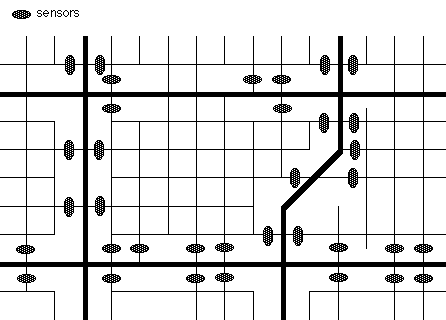Neighborhoods are protected from drivers attempting to avoid arterials (shown as thick lines) by zone charging. Sensors (shown as ovals) are placed to charge a premium to deter traffic from using neighborhood streets (shown as thin lines). Those who have a neighborhood destination are not charged. This is if they stay a specified minimum time, or leave by the same route.
This method also increases efficiency of neighborhood traffic. Most four-way stops signs are placed not for safety but for another purpose. The purpose is to deliberately cause inefficiency to drivers to discourage them from using neighborhood streets. Other inefficiencies currently used are "no right turn" signs, closing of streets to through traffic, and winding, random and intermittent street patterns. The deliberate inefficiencies also discourage bicycling and walking. Four-way stop signs greatly slow bicycling. Pedestrians are effected by increasing the walking distance. This also decreases transit patronage.
These inefficiencies can now be eliminated without adding to neighborhood car traffic by use of zone charging. Not every entrance to the neighborhood needs a sensor. For example, the some streets below do not have sensors where leaving them out would not encourage a driver to shortcut through the neighborhood.
